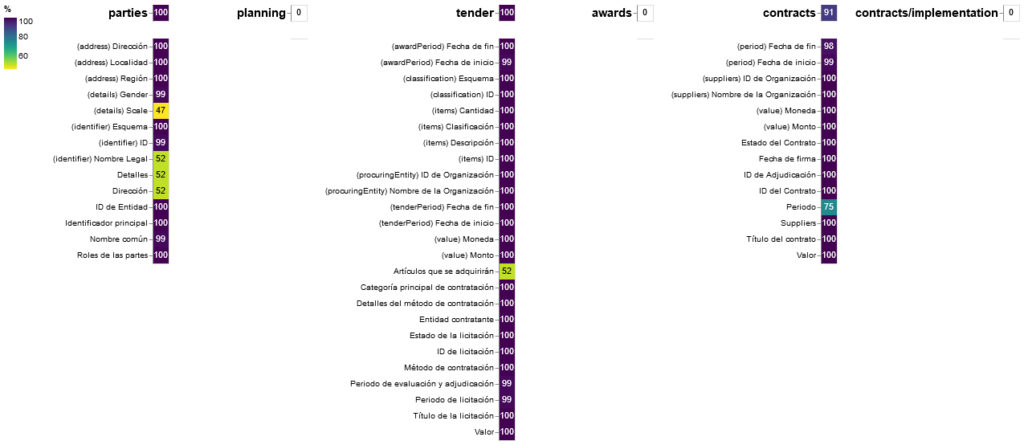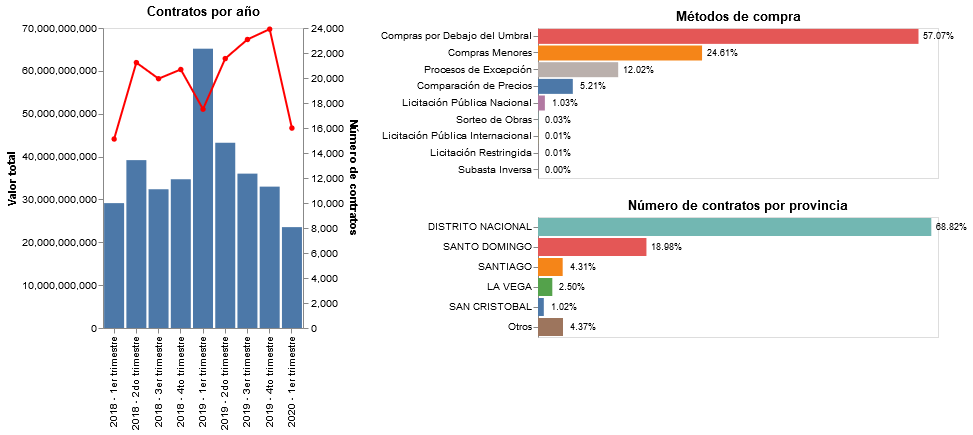Dominican Republic: publishing open data for equal opportunities
In April 2020, the Dominican Republic’s General Directorate of Public Procurement began publishing data on its open data portal following the Open Contracting Data Standard (OCDS).
Along with transparency and social responsibility, the directorate’s motivation for publishing data in open formats was to promote equal opportunities in public procurement, especially for micro, small and medium-sized companies, women-run businesses, and firms based outside Santo Domingo and the National District (the zone surrounding the capital). Publishing data can contribute to achieving this objective, since it allows potential suppliers to analyze public contracts in their fields of interest and for any prospective vendors to examine current tenders and propose their ideas for improvement.
Can the OCDS help with this goal? Although the standard does not include the necessary data fields about suppliers by default, they can be added through extensions. In the case of the Public Procurement Directorate, they made use of an existing OCDS extension and created a new one, as we will discuss in a moment.
In this blog post, we will take a look at the Public Procurement Directorate’s data, highlighting how it can help to monitor equal opportunities in public procurement using indicators such as company size and the business owner’s gender. We will also show how the OCDS is used to actually publish the data.
Data coverage and completeness
Let’s start by looking at the data. The dataset contains historical data from 152,884 contracting processes, from January 2018 (the first full year that use of the Transactional Portal became mandatory) to March 2020, and the data is updated at the end of each quarter. The existing data covers the tender and contract stages of the procurement process only.
The image below shows the coverage of each OCDS field in the dataset. Although we note the lack of data in other phases of the contracting process, the tender and contract stages contain a large number of fields.

We can see that the coverage is high for most data fields. If a field is not used consistently in the data, it may not be very useful for data analysis. The following charts show some calculations that can be made with existing data, such as the number and value of contracts per year, the procurement methods used for tenders and the distribution of contracts by province (where the supplier is based).

Looking at the data fields in the coverage graph, the tender/items section ( “Artículos que se adquirirán”) is the one with the lowest coverage, at 53%. Item data would be very useful to understand what is being purchased and to identify opportunities for improvement in public contracts.
Tracking data on smaller and women-run suppliers
Now, let’s see what the published data reveals about equal opportunities for suppliers according to two criteria: gender and company size.
The supplier registry of the Public Procurement Directorate includes information on the participation of women’s companies. The supplier is classified as “female” if a woman owns the company, if most shareholders are women, or if the vendor is a self-employed woman. The directorate provides this data in OCDS through its own gender extension, since the standard does not include these fields by default.
The image below shows the distribution of contracts by year and by supplier’s “gender classification”. This information can be cross-referenced with other data sources to determine if these percentages are as expected or if they could be improved.

Information on company size is also registered by the directorate using a “scale” classification, which includes the codes shown in the image below. The categories range from person (for an independent worker) and micro (microenterprises with no more than 10 employees) to large (for large companies with more than 150 employees). To include this data in OCDS, the Public Procurement Directorate created its own extension, which is based on the existing OCDS extension partyScale.
The image below shows again the distribution of contracts by year and by company size.

Despite the importance of this data field, it should be noted that for more than 50% of suppliers there is no information on the size or scale of their company. Increasing the quality of the information would enable evidence-based strategies to be developed to increase the participation of companies of different sizes.
While the gender data is quite comprehensive and can be used to monitor women’s opportunities in public procurement, more coverage is needed to do the same with vendor scale data.
Available formats
This dataset is published in CSV and JSON formats. Publishing in tabular formats such as CSV is very useful to make data available to less technical users, and those who feel more comfortable analyzing data in a spreadsheet processor.
The data is initially produced in CSV format and the flatten-tool is used to produce the JSON version. This strategy has been previously used by other publishers such as the City of Buenos Aires City and the public procurement agency in Paraguay, since it can be much easier to convert data from tables in databases to other tabular representations.
As the data is originally produced as CSV tables and no award data is included, the Public Procurement Directorate uses the contract suppliers extension to include the supplier data in the contracts section. This prevents them from producing an additional spreadsheet with supplier data only.
Recommendations for improvement
The data published by the General Directorate of Public Procurement is very useful for analyzing public purchases, including monitoring equal opportunities for women-run companies.
In particular, the directorate’s data and extensions provide a good example for other publishers interested in disclosing more information about their suppliers.
The directorate may benefit from increasing its coverage of data on purchased items and the size (or scale) of its suppliers. Similarly, increasing the frequency of publication to have real-time data would enable effective citizen oversight and contribute to evidence-based decision-making. This is especially relevant amid the COVID-19 crisis, in which open data published in real time can be crucial for effective resource management. In the Dominican Republic, contracting data related to the emergency can be found on its Procurement Portal, using keywords such as “COVID”.
If your organization is interested in publishing OCDS data on supplier classifications, contact us and we will be happy to help you.